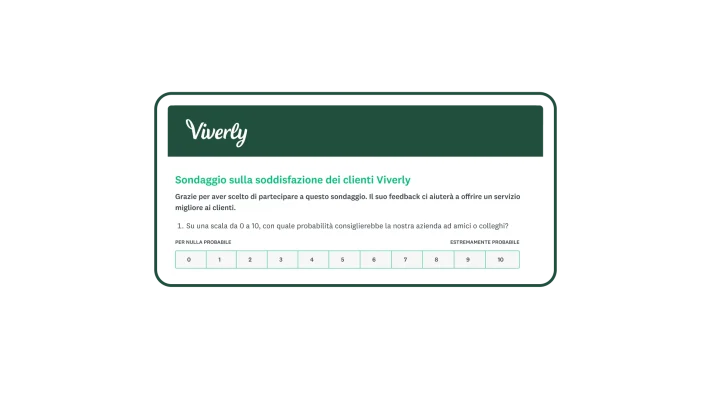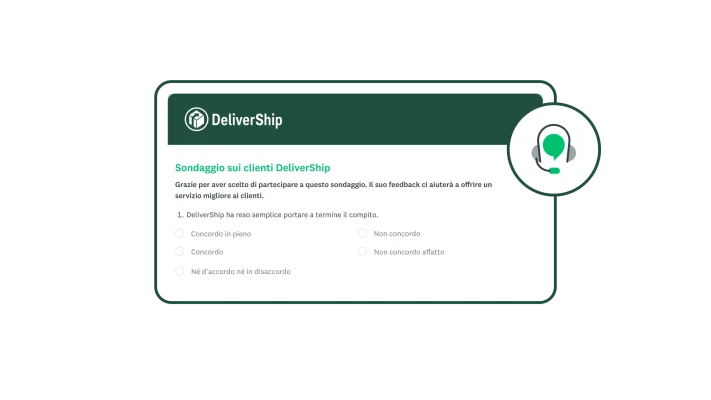Come creare un programma Voce del cliente efficace

Ti è mai capitato di evitare un marchio a causa di qualcosa che avevi sentito dire? O di smettere di acquistare da un'azienda che non ha soddisfatto le tue aspettative?
Quante volte hai contattato queste aziende per spiegare perché non compri da loro?
Se ti occupi di migliorare l'esperienza dei clienti (CX) non puoi aspettarti che siano i consumatori a venirti a cercare. Al contrario, devi essere tu a iniziare la conversazione, promuovendo, implementando e curando per la tua organizzazione un programma Voce del cliente (o VoC da Voice of the Customer).
Che cos'è un programma Voce del cliente?
Per Voce del cliente si intende la raccolta, l'analisi e il monitoraggio sistematici delle interazioni dei clienti con i prodotti, i servizi o il marchio dell'azienda.
Un programma VoC ben congegnato è importante per migliorare l'esperienza dei clienti nel suo complesso. Si tratta essenzialmente di un impegno ad agire sulla base del feedback dei consumatori. L'obiettivo iniziale è quello di colmare il divario tra le prestazioni della tua azienda e le aspettative dei clienti, ma il mantenimento di un programma VoC efficace permetterà addirittura di superarle.
Differenza tra gestire un programma VoC e raccogliere il feedback dei clienti
Molte organizzazioni chiedono ai clienti riscontri mediante indagini, moduli di feedback e gruppi di discussione. Ma un programma Voce del cliente va oltre la semplice raccolta di feedback. Sviluppando un programma VoC, si fa del coinvolgimento, della fedeltà e della soddisfazione dei clienti il cuore della strategia aziendale. Un buon programma VoC prevede:
- Obiettivi di business concreti
- Supporto da parte del team dirigenziale
- Partecipazione e collaborazione del personale
- Analisi completa del percorso del cliente
- Ascolto proattivo dei clienti attraverso i vari canali e punti di contatto
- Ricerche periodiche sui clienti e sul mercato
- Analisi dei dati e stesura di report
- Comunicazione interna
Più di ogni altra cosa, un buon programma VoC prevede degli interventi. Le aziende si impegnano a chiudere il ciclo di feedback identificando le criticità, risolvendo i problemi e comunicando i cambiamenti sia ai dipendenti che ai clienti.
Continua a leggere per scoprire come creare il tuo programma Voce del cliente, dalla pianificazione all'implementazione e gestione nel tempo. Troverai suggerimenti, metriche chiave e risorse per aiutarti a iniziare, come questi modelli di indagine Voce del cliente.
Creazione di un programma Voce del cliente
1. Ottenere il consenso e il supporto della dirigenza
Creare un programma VoC, o anche aggiornarne uno esistente, richiede tempo e risorse. Prima di avviare un piano completo, raccogli le seguenti informazioni e presentale alla leadership per assicurarti che tutti siano d'accordo:
- Principali criticità dei clienti o metriche che li riguardano (per esempio, un aumento del 5% su base annua del tasso di abbandono dei clienti).
- Che cos'è un programma VoC oppure come pensi di trasformare il programma VoC esistente.
- Alcuni casi di studio di altre aziende che dimostrano quanto sia importante dare priorità all'ascolto dei clienti e agire di conseguenza. Un esempio è il caso della compagnia di autobus americana Greyhound, che ha incrementato di 15 punti una metrica chiave di fidelizzazione e ha introdotto modifiche cruciali all'esperienza dei clienti, ottenendo un impatto positivo sulla redditività.
2. Collaborare con le principali parti interessate per definire gli obiettivi
Una volta ottenuto l'appoggio della dirigenza, è necessario interagire con i diversi team dell'azienda. Ogni parte interessata avrà una prospettiva unica sull'esperienza del cliente e proposte diverse per migliorarla.
- I team dell'assistenza e del successo dei clienti lavorano a stretto contatto con la clientela, riuscendo a capire quali sono le principali criticità e i problemi del prodotto o del servizio.
- Il reparto marketing e comunicazione disporrà di informazioni chiave sulla concorrenza e sul mercato. Questi team possono anche comunicare direttamente con i consumatori sui social media.
- Il personale di vendita avrà una buona percezione della sensibilità al prezzo, dei prodotti e delle soluzioni della concorrenza e del tipo di comunicazione più (o meno) efficace con i potenziali clienti.
- I team di prodotto possono aiutare a capire come le persone interagiscono con il prodotto o servizio, fornendo anche dati come i tassi di abbandono o di errore. Possono anche aiutare a comprendere meglio il funzionamento dei prodotti e gli eventuali difetti o problemi che potrebbero influire sulla soddisfazione dei clienti.
- Le risorse umane o la gestione aziendale possono esprimersi in merito all'esperienza dei dipendenti. Il personale è motivato nel proprio lavoro? Si sente in grado di dare un contributo positivo all'esperienza dei clienti?
Ognuno di questi team potrebbe avere obiettivi o idee di successo differenti. Per iniziare, potresti scegliere un obiettivo a livello aziendale (ad esempio, "migliorare il punteggio di soddisfazione dei clienti del 10%") e invitare ogni team a fissare il proprio obiettivo.
Ricorda che si tratta di un'iniziativa incentrata sul cliente. Il team di prodotto relativo a un servizio, ad esempio, potrebbe voler migliorare l'esperienza di onboarding per incrementare il numero di adesioni. Ma nel contesto di un programma Voce del cliente, sarebbe meglio che i team di prodotto e dell'assistenza fossero in sinergia. Il servizio clienti potrebbe evidenziare le principali criticità dell'esperienza di onboarding e il team di prodotto potrebbe affrontarle con l'obiettivo di ridurre il numero di ticket di assistenza.
3. Definire una mappa del percorso del cliente
Confrontati con le principali parti interessate per riflettere sul modo in cui un cliente o un potenziale tale interagisce con il marchio prima, durante e dopo l'acquisto. Si tratta della cosiddetta mappatura del percorso del cliente, che può aiutare a evidenziare le opportunità di raccogliere feedback, di saperne di più su un particolare punto di contatto o di colmare eventuali lacune nell'esperienza dei clienti. I punti di contatto più comuni con i clienti avvengono prima, durante e dopo l'acquisto. Ecco alcuni esempi:
- Prima dell'acquisto: pubblicità, passaparola, social media
- Durante l'acquisto: sito web, negozio online, punto vendita fisico
- Dopo l'acquisto: fatturazione, email transazionali, centro assistenza online
Quando si crea la mappa del percorso del cliente, è importante capire anche quando, dove e quanto spesso si chiede di fornire un riscontro sulle interazioni. Questo ti aiuterà a modificare i sondaggi, a pianificarli e monitorarli più efficacemente.
Ti serve aiuto per mappare il percorso del cliente?
Scopri come creare una mappa del percorso del cliente per allineare le parti interessate e raggiungere gli obiettivi aziendali.
4. Ascoltare regolarmente i clienti
Quando consulti i clienti, raccogli feedback strutturati e non strutturati (quantitativi e qualitativi) della Voce del cliente.
I dati strutturati sono quantificabili o misurabili. Ad esempio, invii un questionario per chiedere ai clienti di valutare la probabilità che acquistino di nuovo dall'azienda. Poiché chiedi loro di scegliere tra una serie di opzioni, otterrai un valore numerico: il 76% dei clienti dichiara che acquisterebbe di nuovo il tuo prodotto.
I dati non strutturati sono qualitativi o non misurabili. Ad esempio, in un sondaggio sull'esperienza di acquisto, puoi chiedere agli intervistati di spiegare perché è "molto probabile" che acquistino di nuovo da te. Fornisci una casella di testo perché possano dirti di più. Le risposte di testo ricevute ti aiuteranno a capire il "perché" dei numeri.
Per avere un quadro completo dell'esperienza del cliente, è bene raccogliere entrambi i tipi di dati. Ecco alcuni metodi per consultare regolarmente i clienti nell'ambito di un programma Voce del cliente efficace:
- Assicurati di raccogliere un feedback mediante indagini sulla soddisfazione dei clienti nei punti di contatto chiave, come ad esempio dopo un acquisto o un'interazione con il servizio di assistenza.
- Incoraggia tutti i team dell'azienda a riunirsi una volta a trimestre con i team di vendita e del servizio clienti.
- Effettua regolarmente ricerche sui clienti o sugli utenti per ottenere informazioni sulla concorrenza e capire dove è possibile migliorare il prodotto o il servizio.
- Organizza dei gruppi di discussione e dei colloqui con i clienti per approfondimenti.
- Monitora i social media per cercare di capire come viene percepito il brand dai consumatori.
5. Monitorare le metriche chiave della Voce del cliente
Esistono alcune metriche VoC standard del settore che le aziende utilizzano per comprendere l'esperienza dei clienti. Ecco le tre più importanti.
Net Promoter Score (NPS)

Con quale probabilità qualcuno consiglierebbe la tua azienda ad amici o colleghi? L'indagine Net Promoter Score® (NPS) risponde in modo quantificabile e facilmente tracciabile a questa domanda. Ecco le principali caratteristiche delle indagini NPS.
- Massima semplicità di calcolo: i rispondenti assegnano una valutazione da 0 a 10 e il punteggio risultante è un numero compreso tra -100 e +100.
- Sistema pratico e facilmente tracciabile: la domanda NPS è semplice e versatile, sia che tu la utilizzi per chiedere a qualcuno se consiglierebbe il tuo marchio, la tua app o un servizio. Non è legata a un evento specifico, quindi è un buon indicatore della performance dell'azienda in generale.
- Utili parametri di riferimento del settore: dal momento che molte organizzazioni utilizzano l'NPS, puoi confrontare le prestazioni della tua azienda con quelle di altre del tuo settore. Ad esempio, in base a una nostra analisi di centinaia di sondaggi NPS, 38 è il punteggio medio per il settore sanitario.
Punteggio di soddisfazione del cliente (CSAT)

Se l'NPS rivela la fedeltà dei clienti nel tempo, il punteggio di soddisfazione dei clienti (customer satisfaction, CSAT) aiuta a capire come si sentono i clienti dopo una specifica interazione con il marchio. Ecco cosa sono le indagini CSAT in sintesi.
- Si combinano perfettamente con i sondaggi NPS: sia CSAT che NPS sono importanti metriche della VoC e forniscono informazioni diverse e complementari sull'esperienza del cliente.
- Specifiche e perseguibili: puoi usare le indagini CSAT per apportare miglioramenti mirati all'esperienza dei clienti. Permettono di raccogliere feedback sull'assistenza clienti o di misurare la soddisfazione dei partecipanti raccogliendo feedback su un evento.
- Massima semplicità di calcolo e analisi: le opzioni di risposta in un sondaggio CSAT si basano su una scala numerica, come da 1 a 5. È possibile esaminare i numeri grezzi, ad esempio 478 clienti hanno dichiarato di essere "molto soddisfatti" della loro recente interazione con il servizio clienti. Oppure puoi visualizzare i dati sotto forma di percentuale.
Punteggio di impegno del cliente (CES)

Quanto è difficile o facile per i clienti portare a termine determinate attività quando interagiscono con l'azienda? Il punteggio di impegno del cliente (customer effort score, CES) aiuta a individuare i principali punti di attrito, come durante l'utilizzo di un software o nel tentativo di risolvere un problema specifico. Ecco alcune valide ragioni per usare le indagini CES a completamento del tuo programma VoC.
- Aumentare la fedeltà dei clienti: secondo una nostra ricerca, il 91% dei consumatori è più propenso a consigliare un'azienda dopo un'esperienza positiva e senza difficoltà.
- Trovare modi rapidi per migliorare: anche semplicemente un messaggio poco chiaro può indurre i clienti ad abbandonare l'acquisto. Magari, cambiando qualche parola nelle istruzioni di checkout, si potrebbero già ottenere risultati tangibili.
- Sviluppare programmi di formazione migliori: puoi usare i sondaggi CES per capire dove il team del servizio clienti è poco performante, ad esempio se gli operatori impiegano troppo tempo per risolvere i problemi della clientela. Se si conoscono le difficoltà dei clienti, si può adattare la formazione per risolvere più rapidamente i problemi più comuni.
6. Analizzare i risultati
Dopo aver iniziato a raccogliere i feedback dei clienti nei vari punti di contatto, è necessario esaminare ogni serie di dati e confrontare i risultati.
- Chiedi ai tuoi colleghi da ogni dipartimento di condividere gli approfondimenti raccolti dalle ricerche sui clienti e sul mercato, dai canali social e altro. Tutte queste informazioni dovranno essere accessibili in un unico luogo, come un wiki interno o un sito web.
- Alcuni dati, come il Net Promoter Score, sono facilmente comprensibili anche a un livello più generale. Ma se si raccolgono feedback aperti nelle indagini sui clienti, è opportuno utilizzare uno strumento di analisi del testo per individuare eventuali dinamiche latenti.
- È consigliabile esaminare a fondo i dati delle indagini con strumenti di analisi avanzati come i filtri personalizzati, che possono arricchire i risultati con informazioni più dettagliate sulla clientela.
7. Intervenire, gestire e iterare
Una volta definita la strategia di ascolto dei clienti, dovrai occuparti di eventuali problemi immediati, come un punteggio NPS in calo o una scarsa soddisfazione dei clienti, e affrontarli.
Nel lungo termine, sarà necessario creare le condizioni per assicurare il mantenimento di un efficace programma VoC all'interno dell'organizzazione. Ecco alcuni suggerimenti.
- Influenzare le roadmap dei prodotti: i team di prodotto possono impegnarsi a risolvere uno o due problematiche urgenti della clientela una volta al trimestre.
- Migliorare la formazione e la risposta del servizio clienti: i team dell'assistenza possono dare priorità a un migliore inserimento dei dipendenti e a corsi di formazione sull'empatia. Oppure possono predisporre dei modelli di risposta alle domande più frequenti, per ridurre i tempi di attesa.
- Coinvolgere tutta l'azienda: dedica una o due settimane ogni sei mesi a risolvere i problemi dei clienti o a rispondere ai feedback di quelli più importanti.
- Mantenere i clienti al centro della tua attività: invita periodicamente i clienti a raccontare le loro storie ai dipendenti.
- Condividere le lacune e i successi: considera la possibilità di distribuire un report mensile a tutta l'azienda che metta in evidenza i feedback più importanti, le tendenze dei dati e le testimonianze dei clienti, in modo da motivare i dipendenti.
Vantaggi di un programma Voce del cliente
Se i clienti sono soddisfatti, è più probabile che restino fedeli al marchio e che lo raccomandino ad altri. Ma ci sono anche altri vantaggi del programma Voce del cliente che potrebbero non essere così evidenti.
Miglioramento del coinvolgimento dei dipendenti
Quando si crea un programma VoC, si dà ai dipendenti la possibilità di influire direttamente sull'esperienza dei clienti. Puoi anche incoraggiare i team a fissare degli obiettivi in tal senso e premiarli per i risultati ottenuti.
Acquisizione di un vantaggio competitivo
Gran parte della raccolta di feedback è reattiva, vale adire che si è in grado di capire come si sentono i clienti solo dopo la loro interazione con il marchio. Un programma VoC prevede anche la raccolta di feedback proattivi. Gruppi di discussione, colloqui con i clienti, monitoraggio dei social media, ricerca sugli utenti: sono tutti modi per trovare opportunità di sviluppare nuove idee di prodotto, risolvere le problematiche dei consumatori e molto altro.
Raccolta di un numero ancora maggiore di testimonianze di clienti e di "social proof"
Puoi usare i feedback e le interazioni positive dei clienti per fornire testimonianze significative sul tuo marchio nei vari canali, dal materiale di marketing al sito web e alle piattaforme social.
Come superare le difficoltà comuni dei programmi VoC
Sfida n. 1: Isolamento di dati e feedback dei clienti
Ricerche di mercato, approfondimenti sugli utenti, feedback del servizio clienti, interazioni sui social media, risultati dei sondaggi: tutti i dati si integrano per fornire un quadro completo dell'esperienza dei clienti. Ma se le informazioni sono frammentate, diventa difficile individuare le tendenze ed evidenziare le opportunità più importanti per i vari team dell'organizzazione.
Fai in modo che ciascun soggetto o team sia responsabile di riferire sui propri risultati o di condividere tutte le informazioni in un unico luogo. Puoi semplificare la raccolta e la gestione dei feedback con le integrazioni dei dati delle indagini in Salesforce, HubSpot, Mailchimp, Zendesk, Zoom e altro.
Sfida n. 2: Mancata partecipazione ai sondaggi di feedback
Distribuisci sondaggi ma non ottieni abbastanza risposte per avere risultati statisticamente significativi? Nell'ambito del tuo programma VoC, prendi in considerazione la verifica delle indagini, ovvero l'analisi di ogni questionario in base a una lista di controllo delle migliori pratiche.
I clienti potrebbero ignorare i tuoi questionari se sono troppo lunghi o confusi. Per questo è consigliabile utilizzare modelli e domande di indagine sulla soddisfazione dei clienti scritti da esperti per ottenere un buon numero di risposte affidabili.
Hai ancora dei dubbi sul motivo per cui i tuoi sondaggi non funzionano al meglio? Dai un'occhiata a questi suggerimenti per aumentare le percentuali di risposta CSAT e alle linee guida per le domande d'indagine CSAT.
Sfida n. 3: Alcuni team non sono interessati a partecipare
Se l'idea di accontentare i clienti non è uno stimolo sufficiente a convincere i team a mettere in primo piano la risoluzione dei loro problemi, è necessario associare la soddisfazione dei clienti ai profitti. Ad esempio, per dimostrare il ROI derivante dal miglioramento della soddisfazione dei clienti, puoi collegare il lifetime value di un cliente fidelizzato al numero di persone che si dichiarano disposte ad acquistare di nuovo dalla vostra azienda.
Consolida la tua tesi condividendo ricerche convincenti con i team più esitanti. Una nostra ricerca ha rivelato, fra altri importanti risultati, che il 75% dei clienti perde fiducia in un'azienda dopo una cattiva esperienza con il prodotto.
5 linee guida per creare un programma Voce del cliente
Elabora un programma di VoC in grado di cogliere lo stato d'animo dei clienti. Usa le seguenti linee guida per coinvolgere i consumatori in un dialogo, allineare tutte le parti interessate dell'azienda e produrre un cambiamento significativo.
- Presta attenzione ai dati impliciti. I dati impliciti, come l'utilizzo delle app o il tasso di abbandono, sono l'opposto del feedback esplicito dei clienti. Un cliente può dichiararsi soddisfatto della tua app, ma se non la usa più, è il caso di approfondire con altre domande.
- Prima di iniziare il lavoro di analisi, è necessario ripulire i dati dell'indagine per ottenere risultati il più possibile accurati e utili.
- È probabile che più i tuoi collaboratori sono soddisfatti, migliore sarà l'esperienza dei clienti. Collabora con le risorse umane o la gestione aziendale per monitorare il coinvolgimento e la soddisfazione dei dipendenti, ad esempio con un sondaggio eNPS. Puoi anche monitorare e tracciare queste metriche chiave relative ai dipendenti rispetto a quelle relative ai clienti.
- Contestualizza i risultati. Monitorare la soddisfazione dei clienti nel tempo è sicuramente importante. Ma per avere un'idea reale delle prestazioni della tua azienda, dovrai anche confrontarne i risultati con quelli della concorrenza.
- Assicurati che il tuo programma VoC venga sempre aggiornato. Approfondisci le principali tendenze relative all'esperienza dei clienti, come il modo in cui i professionisti CX utilizzano l'intelligenza artificiale e cercano di soddisfare le mutevoli aspettative dei consumatori.
Inizia oggi stesso a creare un programma Voce del cliente
Bastano pochi minuti per inviare un'indagine utilizzando uno di questi modelli per la Voce del cliente scritti da esperti. Se stai cercando un aiuto in più, scopri come SurveyMonkey può sostenere il tuo programma VoC.
Net Promoter, Net Promoter Score e NPS sono marchi commerciali di Satmetrix Systems, Inc., Bain & Company, Inc. e Fred Reichheld.
Scopri altre risorse

Indagini sulla soddisfazione dei clienti
Scopri i nostri modelli sulla soddisfazione dei clienti per raccogliere rapidamente dati, individuare criticità e migliorare l'esperienza dei clienti.

Scopri come Ryanair acquisisce informazioni CSAT su larga scala
Scopri come Ryanair usa SurveyMonkey con Microsoft Power BI per monitorare 50.000 indagini CSAT al mese e migliorare l'esperienza dei clienti.

Scopri in che modo woom migliora l'esperienza dei propri clienti e dipendenti
Scopri come woom usa SurveyMonkey per lanciare sondaggi multilingue, migliorare l'esperienza dei dipendenti e raccogliere la prospettiva dei clienti.

Scopri perché Together Labs si affida a SurveyMonkey per consultare gli utenti
Scopri perché Together Labs ha lasciato Moduli Google ed è passata a SurveyMonkey Enterprise per raccogliere un feedback degli utenti approfondito.